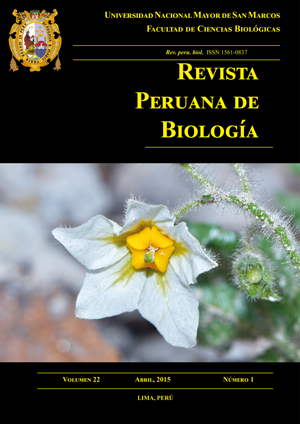Vegetation of a Polylepis incarum forest (Rosaceae) in Lampa district, Puno, Peru
DOI:
https://doi.org/10.15381/rpb.v22i1.11125Keywords:
vegetation, phytosociology, queñual, Lampa, Puno.Abstract
The vegetation of the Polylepis incarum (Bitter) M. Kessler & Schmidt-LeBuhn forests was studied in the Lamparaquen annex in the province of Lampa, Puno department in 2009 and 2014. A total of 83 vascular species belonging to 35 families were determined. The lifeforms are represented by herbs, grasses, shrubs and trees, being mostly native and endemic species with some introduced. The queñoal ecosystem is represented by the new phytosociological unit Lupino chlorolepis-Polylepidetum incari with four subassociations identified. The floristic composition shows a moderate to high species richness, being the most representative families, Asteraceae, Poaceae, Caryophyllaceae, Fabaceae and Pteridaceae. The Braun-Blanquet phytosociological method was applied for the analysis of the vegetation units. The classification of communities was done by means of TWINSPAN software, DCA ordination analysis with CANOCO 4.5 software and a dendrogram based on the correlation of species for each quadrant which was performed with PC-ORD software. Further studies are still needed to have a broader view of the plant communities in other geographic areas, and evaluate how vegetation may be affected by climate change and human actions.Downloads
Downloads
Published
Issue
Section
License
Copyright (c) 2015 Daniel B. Montesinos-Tubée, Ángel C. Pinto, Diana F. Beltrán, Washington Galiano

This work is licensed under a Creative Commons Attribution-NonCommercial-ShareAlike 4.0 International License.
AUTHORS RETAIN THEIR RIGHTS:
a. Authors retain their trade mark rights and patent, and also on any process or procedure described in the article.
b. Authors retain their right to share, copy, distribute, perform and publicly communicate their article (eg, to place their article in an institutional repository or publish it in a book), with an acknowledgment of its initial publication in the Revista Peruana de Biologia.
c. Authors retain theirs right to make a subsequent publication of their work, to use the article or any part thereof (eg a compilation of his papers, lecture notes, thesis, or a book), always indicating its initial publication in the Revista Peruana de Biologia (the originator of the work, journal, volume, number and date).






